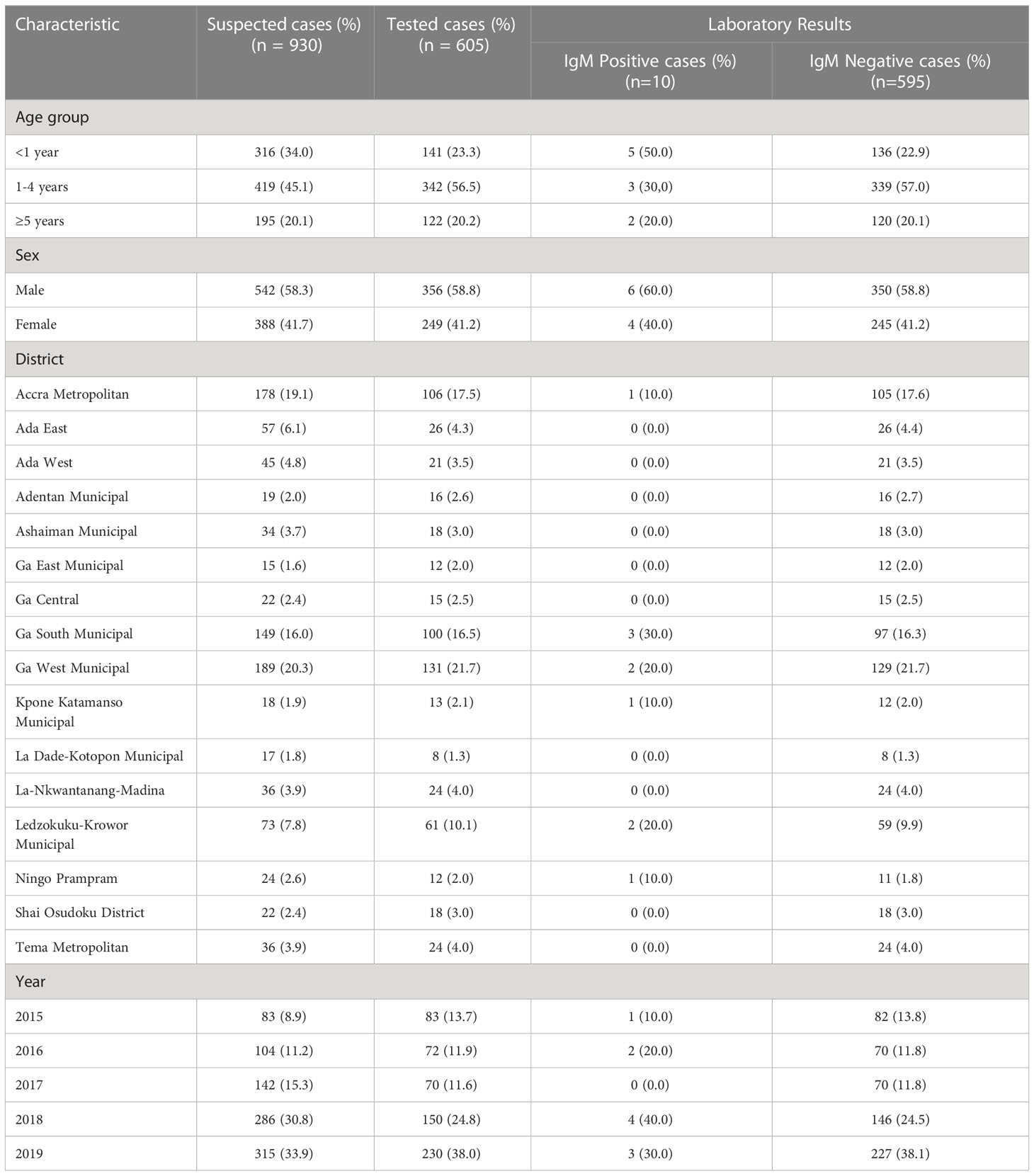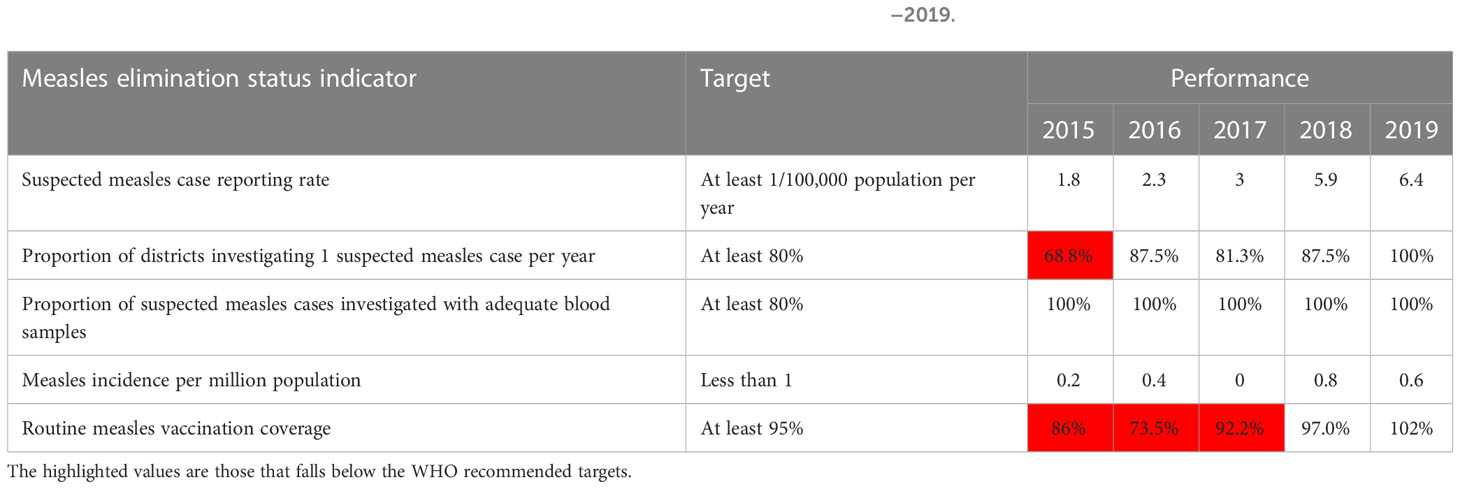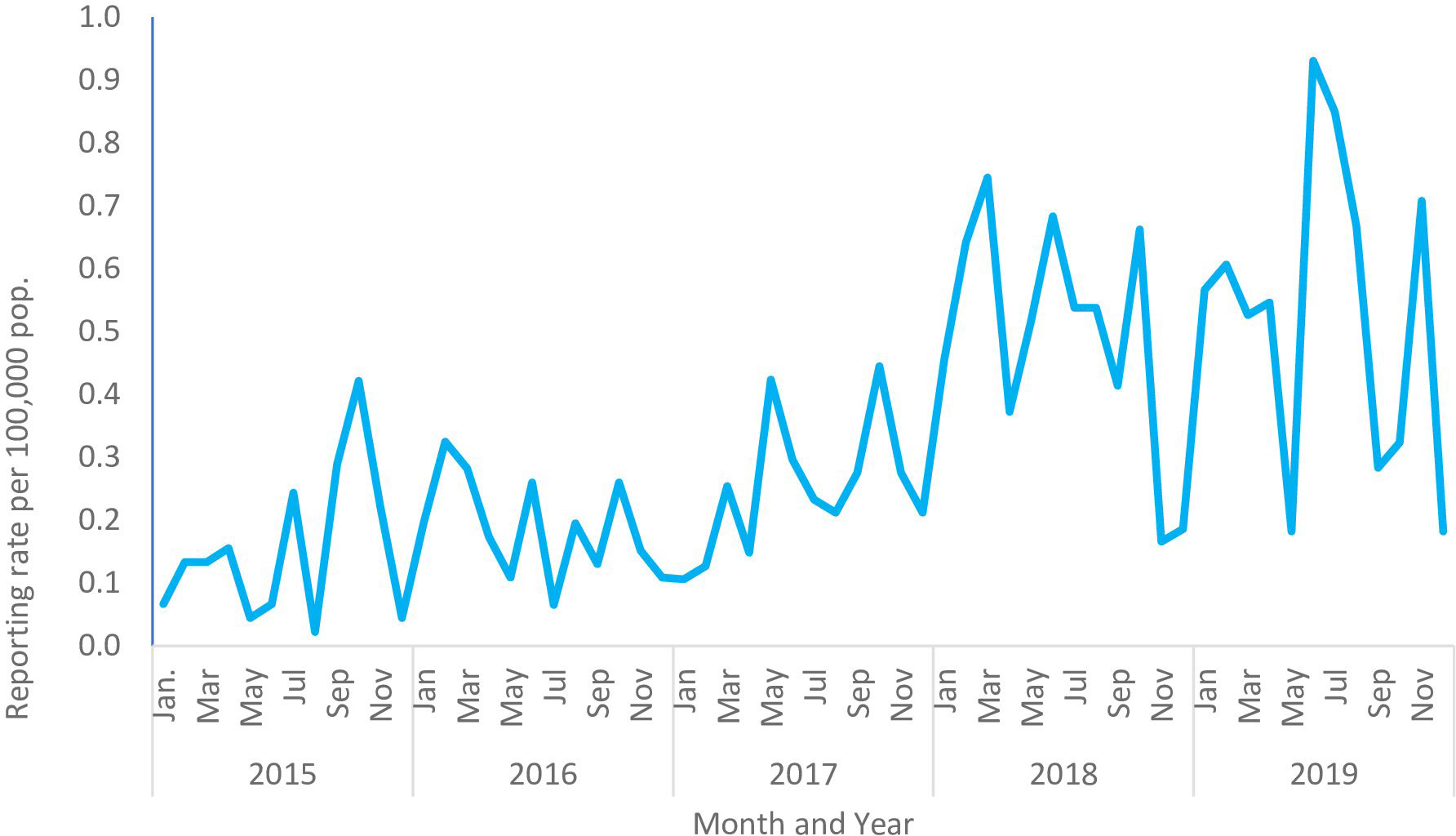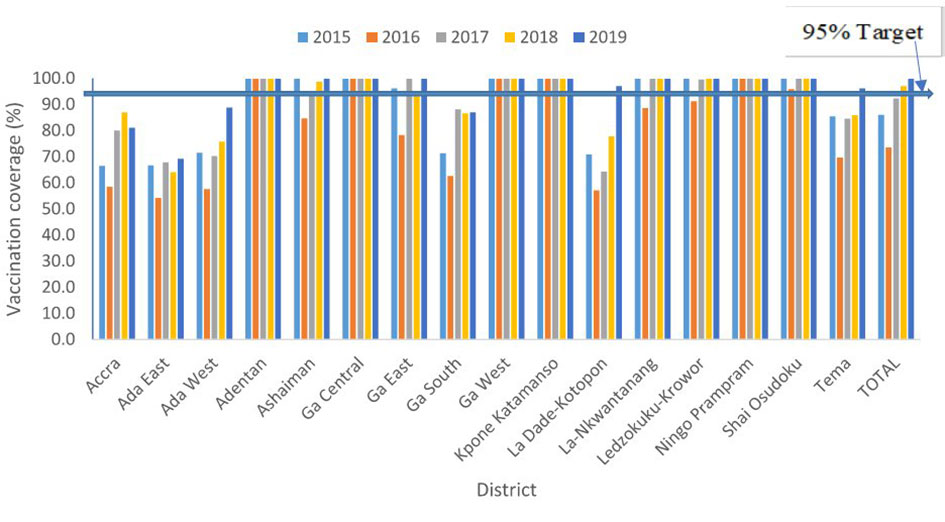- 1Ghana Field Epidemiology and Laboratory Training Program, School of Public Health, University of Ghana, Accra, Ghana
- 2Ghana Health Service, Directorate of Health, Pusiga, Ghana
- 3Sierra Leone Field Epidemiology Training Program, Ministry of Health and Sanitation, Freetown, Sierra Leone
Introduction: Although measles is targeted for global elimination by 2020, an estimated 869,770 measles cases and 207,500 deaths occurred in 2019. Ghana adopted the World Health Organization measles elimination strategies, however, evidence of a systematic, comprehensive analysis of data tracking progress towards elimination is sparse. We analyzed measles data to describe its epidemiology, surveillance, and vaccination coverage performances in the Greater Accra Region.
Methods: We reviewed and conducted a descriptive analysis of measles surveillance, laboratory, and vaccination data for 2015 to 2019 obtained from the regional health directorate and National public health reference laboratory. Case patients’ demographic and clinical variables were analyzed into frequencies, proportions, and rates. We used WHO measles elimination performance targets; at least one suspected measles case reported per 100,000 population, 80% of suspected measles cases investigated with adequate blood samples, measles incidence <1/1,000,000 population, 95% routine vaccination coverage and during SIAs as benchmarks.
Results: Of 930 suspected measles cases reported, 605(65.1%) were tested. Males accounted for 356(58.8%); 141(23.3%), 342(56.5%), and 122(20.2%), were children <1, 1–4, and ≥5 years old respectively. Of those tested, 10(1.65%) were measles IgM confirmed, of which 7(70.0%) had received at least one dose of measles vaccine. Annualized measles reporting rate ranged from 1.8 to 6.4 per 100,000 population from 2015 to 2019. District specimen collection rate was 100%, and measles incidence was between 0 – 0.6 per million population in the period 2015–2019. Measles vaccination coverage increased from 73.5% in 2016 to 102% in 2019 with 75% of districts achieving 95% coverage in 2019.
Conclusion: The measles case-based surveillance system and vaccination program in the Greater Accra region showed an increasing level of performance towards Ghana’s elimination status. However, performance in laboratory testing of blood specimens was suboptimal. Authorities of Ghana’s health system should strengthen laboratory capacity for prompt diagnosis of measles.
1 Introduction
Measles was targeted for global elimination in six WHO Regions under the Global Vaccine Action Plan by 2020 yet, it remains among the top causes of childhood deaths (1). Measles cases have recently rebounded in all regions of the world, and the global incidence doubled from 2017 to 2018 (2, 3). The number of measles cases increased globally by nearly six-fold, from 132,490 in 2016 to 869,770 in 2019 (3). Global estimated measles deaths were 142,000 in 2018 (4) and 207,500 in 2019 (5). The WHO African Region (AFR) recorded over a sixteen-fold increase in the number of reported measles cases since 2016 (3). In response, measles control activities have been instituted.
WHO African Region countries started an accelerated measles control activity in 2001, to reduce measles-related deaths by half by 2005 (6). To achieve this goal, a variety of strategies were implemented, including strengthening routine immunization, providing opportunities for measles vaccination through supplementary immunization activities (SIAs), conducting case-based measles surveillance, and providing standard case management to measles cases (6). Following the successful implementation of these strategies across the region, reported measles cases and estimated measles mortality reduced by 92 percent by 2008, compared to reported measles cases and estimated measles mortality in 2000 (6). The goals for regional measles elimination by 2020 were adopted by the WHO African Region Committee at its September 2011 summit (7). To achieve this goal, key performance indicators were adopted for the measles surveillance system. Since measles elimination by 2020 was not achieved, WHO Africa Region has set the same target to be achieved by 2030 in line with seven strategic priorities set out in the Measles and Rubella Strategic Framework 2021–2030 (4), and Ghana has also revised its timeline for achieving measles elimination target accordingly.
A scorecard of progress towards measles elimination shows an increase in measles incidence in Ghana over the last five years from 0.8 in 2015 to 41.9 in 2019 per one million population (8). Measles-related deaths in Ghana also increased from 160 in 2018 to 587 in 2019 (9). Ghana has an established surveillance system across all regions and districts. All regions and districts have surveillance officers and Rapid Response Teams (RRT) who are responsible for managing the surveillance system including detection, investigation and response to outbreaks and public health emergencies (10). The effectiveness of measles surveillance depends on quality data collection, collation, analysis and dissemination to inform decisions and actions. Routine surveillance data analysis is critical for determining the causes of measles outbreaks, obtaining guidance for control strategies, anticipating potential outbreaks, implementing vaccine strategies to prevent outbreaks, and developing measles elimination initiatives (6, 7). However, evidence of a systematic, comprehensive analysis of data tracking progress towards elimination in the Greater Accra region is sparse. With Ghana’s aim to eliminate measles by 2020 unmet, we analyzed measles surveillance and vaccination data from 2015 to 2019 to assess where the Greater Accra region stands in relation to Ghana’s measles elimination targets.
2 Methods
2.1 Study design
We conducted a cross-sectional study using secondary data generated by the routine measles surveillance system and vaccination program from 2015 to 2019 in the Greater Accra Region of Ghana.
2.2 Study setting
The study was conducted in Ghana’s Greater Accra region from July 27 to September 4, 2020. This region was chosen for the surveillance data analysis because it is the region with the capital city and the most densely populated in the country (11). The Greater Accra region is the smallest of Ghana’s sixteen administrative regions in terms of area yet the second-most populous (11). Its 2020 projected population is estimated at 5,055,883. Of these, 4% (202,236) are under age one year old, 13.5% (682,545) are under age five years old (11). Greater Accra region has a total of 614 health facilities, 275 of these are government-owned and 339 are privately owned (12). Ghana monitors 22 diseases on immediately reportable and on weekly basis through its Integrated Diseases Surveillance and Response (IDSR) system. Measles is one of the immediately notifiable diseases. All government-owned and private healthcare facilities participate in the surveillance system. The National Disease Surveillance System of Ghana makes it a mandatory requirement that all suspected cases of epidemic-prone diseases be reported immediately through the IDSR system to the relevant local health department by health workers within 24 hours of detection. The disease control and surveillance officers at district/municipal levels work with the sub-district level disease control officers to initiate investigations of suspected cases within 48 hours of receipt of case notification. Measles, being an epidemic-prone disease, is reported within the context of the IDSR immediately as a case is detected, and cumulatively every week, which includes zero reporting.
There is at least one designated disease surveillance officer in each of these health facilities who coordinates measles surveillance activities within their respective catchment communities. Additionally, Community-Based Surveillance Volunteers (CBSVs) who have been trained on community case definitions of measles and other notifiable diseases detect and report measles cases from the community level. There is at least one CBSV in each community and CBSVs report any suspected cases of priority diseases or events of public health concern including measles to the surveillance officers in their nearest health facility through community health nurses who serves as supervisors for the CBSVs. At the health facility level, in addition to the routine patient treatment registers, data collection and reporting are done using two (2) data collection instruments: The case investigation form [CIF], and the line-list form; and two data reporting tools: weekly and monthly IDSR reporting forms. Case-based information on every suspected case, including laboratory information and blood sample collected at the health facility level is inputted into the CIF and sent to the municipal health directorate. The Municipal Health Directorate retains a duplicate of the CIF. It forwards the original copy of the CIF together with the specimen to the Regional Disease Control and Surveillance Unit for onward transmission to the national reference laboratory in Accra for confirmation (using IgM antibody ELISA). Measles samples are further tested for Rubella. If a catchment area or health facility records three or more confirmed measles cases within a month, an outbreak of measles will be declared in that area. All subsequent suspected cases are then line-listed at the health facility level and information forwarded to the municipal health directorate; the information is then shared with the regional health directorate.
2.3 Data collection
Data were extracted from the District Health Information Management System (DHIMS). Line lists and laboratory data for all measles cases reported from 2015 to 2019 were obtained from the Regional Health Directorate and Regional Public Health Laboratory in Microsoft Excel and used for the analysis.
2.3.1 Selected measles elimination indicator targets and definitions
We used the African regional guidelines for measles and rubella surveillance (6). to estimate five fundamental indicators to track progress toward Ghana’s measles elimination goal defined as below (Table 1).
2.4 Data analysis and data quality assurance
We used Microsoft Excel 2019 and Stata version 16 for all analysis in this study. Data were cleaned by the researcher in collaboration with the regional disease control officer in Microsoft Excel 2019, exported to Stata version 16 and analyzed descriptively. The epidemiology of measles cases was described using age, sex, vaccination status and by districts. We categorized all variables. Sex was categorized as male and female; age was categorized into three, –under 1 year, 1–4 years, and 5 years & above. Vaccination status was indicated by vaccinated, unvaccinated, and unknown; and all sixteen health reporting districts were listed. We used the 2010 population census (11) as a baseline to project yearly populations used as denominators in our calculations for each of the five years under review. Selected measles elimination status indicators, epidemiology of cases, and vaccination coverage were descriptively analyzed using frequencies, rates or proportions, and presented in text, tables and graphs.
2.5 Ethical considerations
This analysis was conducted as part of routine surveillance function using routine surveillance data; hence, no ethical approval was required. However, permission was obtained from the regional health directorate by the Ghana Field Epidemiology and Laboratory Training Programme before accessing the data sets. The extracted data used for analysis was anonymized before it was accessed and stored on a password-protected computer.
3 Results
3.1 Descriptive analysis of measles cases
From 2015 through 2019, 930 suspected measles cases were reported from all sixteen administrative districts of the Greater Accra region. All 930 suspected cases were investigated with blood samples collected and sent to the laboratory. Of the 930 samples collected, 605 (65.1%) were tested, of which, 10 (1.65%) were laboratory-confirmed for measles IgM, and 35 (5.79%%) were indeterminate (Table 2). Five of the 10 confirmed measles cases were under the age of one year. The median age of confirmed cases was 1.8 years (range 0.6 – 30 years). Six of the 10 cases were males. Six districts reported cases, Ga South Municipal reported the highest, three of 10 cases (Table 2). No measles-related death was reported over the period.
3.2 Measles elimination status indicators - Performance
From 2015 -to 2019, three of five indicators, the annualized measles case reporting rate, the proportion of districts investigating at least 1 suspected measles case for which blood specimen was collected and the incidence of measles cases per million population were consistently met by the region (Figure 1). The proportion of districts investigating 1 suspected measles case per year was achieved in four years except in 2015 highlighted red (Table 3). The target for routine measles vaccination coverage was not met in the first three years highlighted in red. However, the target improved over the years with the achievement of the 95% set target in the last two years 2018 and 2019 (Table 3).
The annualized reporting rate was at 33/100,000 population among the under one-year age groups and 1.7/100,000 population among the age group 5 years and above. The reporting rate was at 14.7 per 100,000 population in Ga West municipal with the lowest in La Dade-Kotopon municipal (1.6per 100,000 population).
Measles reporting rates were relatively high in February, March, May, June, July and October across the five years, ranging from 0.4 in October 2015 to 0.9 in June 2019 per 100,000 population. The annualized measles reporting rate increased yearly, with the lowest reporting rate in 2015 and the highest in 2019 (Figure 1). The highest proportion of laboratory-confirmed measles cases was recorded in May 2018, while no confirmed case was recorded in February, April, July, November and December in all the years (Figure 2).
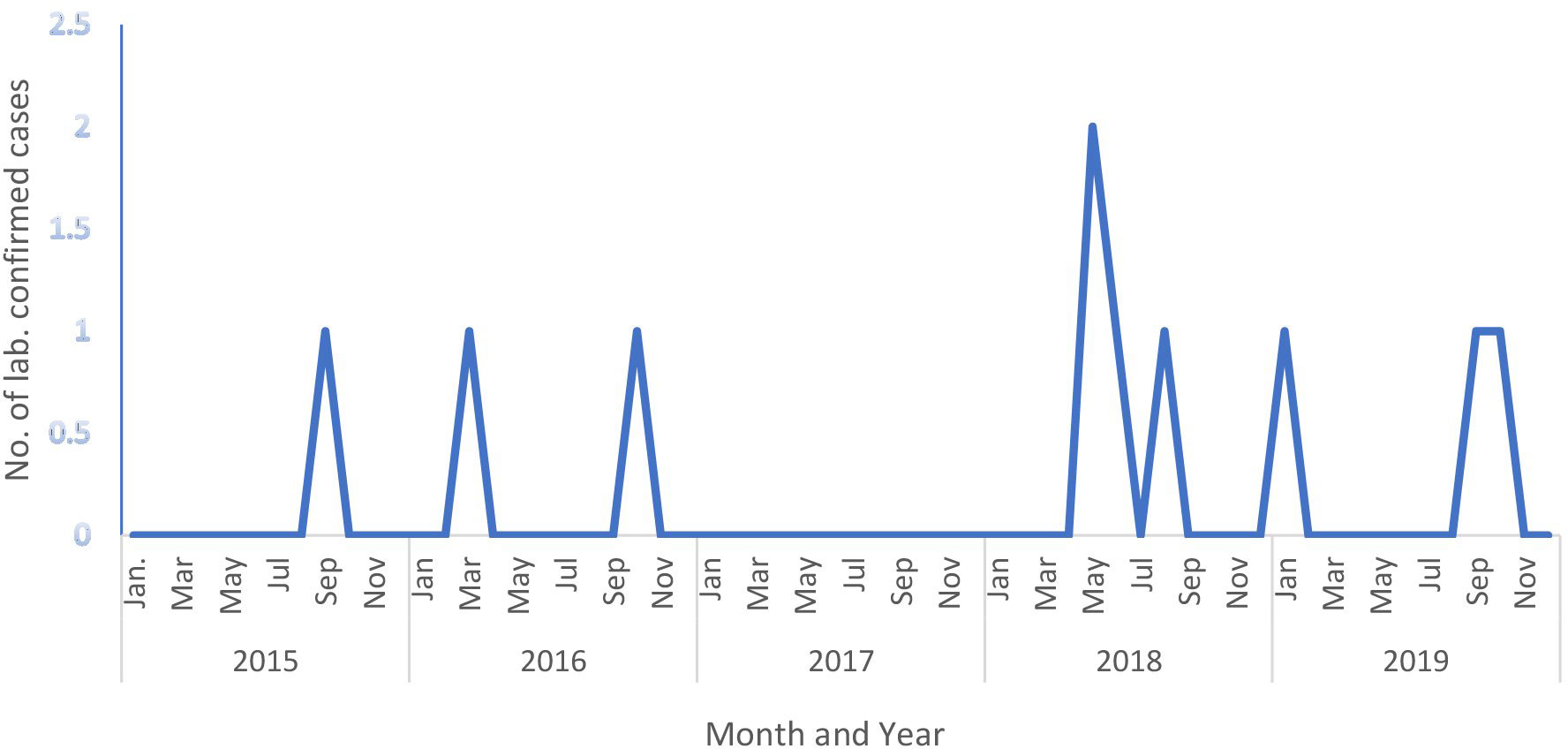
Figure 2 Trends of laboratory-confirmed measles cases by month, Greater Accra Region, Ghana, 2015–2019.
3.3 Vaccination status of reported measles cases
About half 476(51.2%) of the suspected measles cases had received at least a dose of measles-containing vaccine (MCV). Of the laboratory-confirmed measles cases, seven out of 10 had received at least a dose of a measles-containing vaccine (MCV) (Table 4).

Table 4 Vaccination status of measles cases (number/percentage) by final case classification, Greater Accra Region, Ghana, 2015–2019.
3.4 Routine vaccination coverage
Vaccination coverage for measles first dose (MCV1) remained lower than the 95% target in 2015 through 2017 but exceeded the 95% target in 2018 (97%) and 2019 (102%). However, coverage for measles second dose (MCV2) remained consistently lower than the 95% target, and the dropout rate exceeded the 10% threshold in all five years (Figure 3).
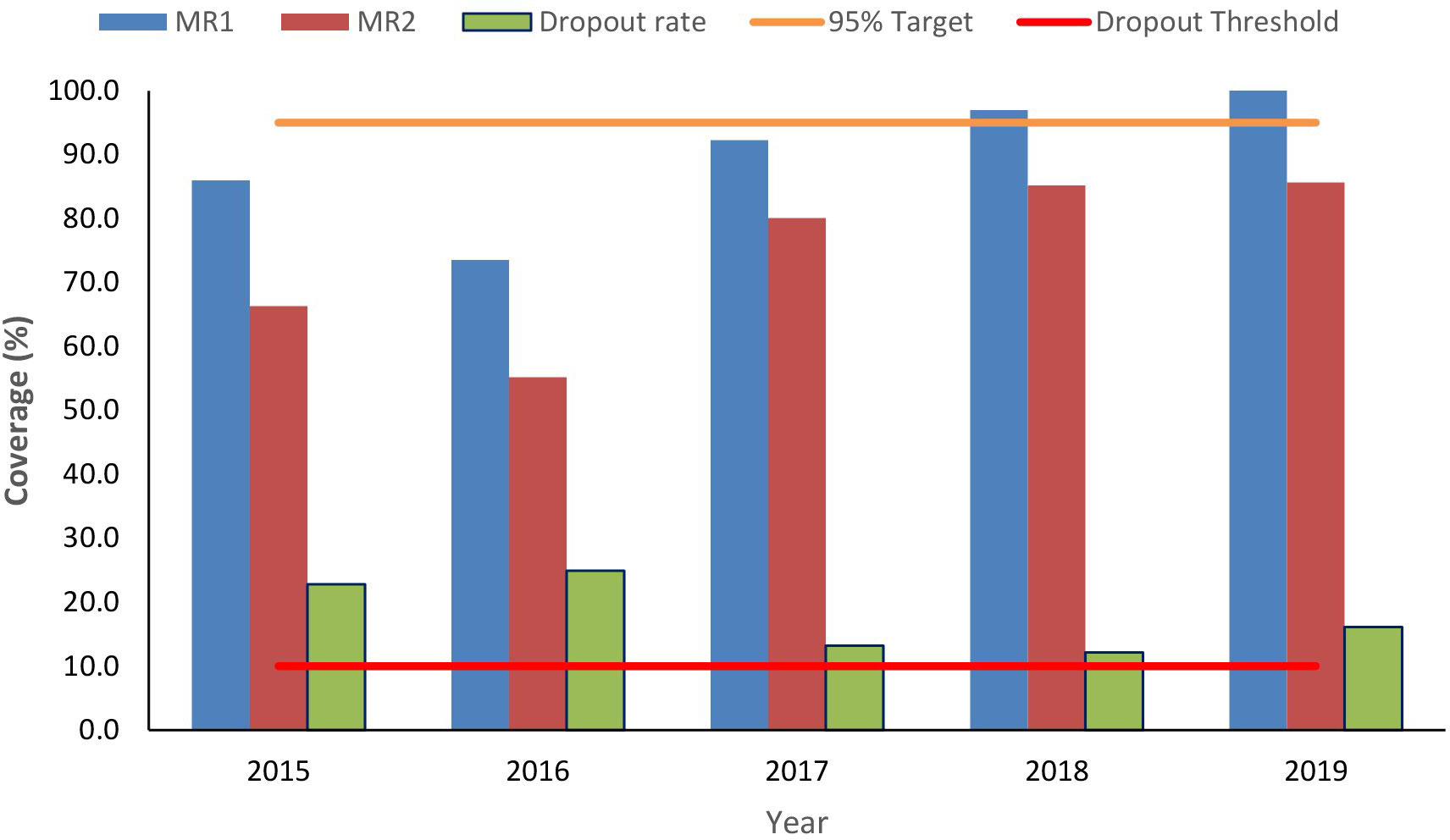
Figure 3 Measles (MR) vaccination coverage and dropout rate by year, Greater Accra Region, Ghana, 2015-2019.
Six (37.5%) of 16 districts consistently achieved the 95% vaccination coverage target for the first doses of measles vaccination (MCV1) across the five years 2015 to 2019. Twelve (75%) of 16 districts achieved the 95% target in 2019 (Figure 4).
4 Discussion
This study sought to describe the epidemiology of measles and to assess the measles surveillance and vaccination coverage performances in the Greater Accra Region towards Ghana’s efforts to attain measles elimination status. We found a high reporting rate of suspected measles cases in all the years under review. The reporting rate exceeded the WHO recommendation of at least one case per million population per year (13) and has increased over the years, reaching its highest in 2019. The increased reporting rates of suspected measles cases could be attributable to the surveillance system’s sensitivity. We also observed a high rate of measles reporting from February to July and in October, compared to a low rate in the other months over the years. This finding is in line with findings of other studies in different urban settings in Africa and Asia (14, 15).These two studies of Degefa et al. and Jasem et al. attributed the seasonality of increased measles reporting rate to seasonal population movement and congregation of children in schools during those periods. The reporting rate in Ga West Municipal, followed by Ada East, was greater than in the other districts and the regional reporting rate. The high reporting rate in these two districts could be due to a highly sensitive measles surveillance system, probably due to the high index of suspicion among clinicians in these two districts.
Blood samples were taken from all suspected measles cases, showing that the region was able to meet the indicator target of collecting serum samples adequate for detecting measles IgM in at least 80% of suspected measles cases. However, only two-thirds of the samples sent to the laboratory were examined, indicating that laboratory confirmation of all suspected measles cases has not been achieved over the years. One-third of the samples sent to the laboratory were rejected and not analyzed due to poor quality in sample collection or sample referral system or other laboratory-related challenges. This implies the need to strengthen the pre-analytical phase of laboratory testing. For countries aiming at measles elimination, all suspected cases of measles should be confirmed as cases or not by laboratory testing (16). It will also allow for the tracking of case decline and progress toward eliminating measles. This finding points to gaps in the essential role of the laboratory in the measles surveillance system. For Ghana to effectively track progress, it would be important to address this gap with the laboratory confirmation of suspected measles cases.
Our analysis show a low incidence of measles in the Greater Accra Region in all the years under review. The incidence is within the acceptable WHO elimination target of less than one confirmed measles case per a million population (6). The incidence of measles in the Greater Accra region was over forty times lower than Ghana’s national measles incidence of 41.9 per million population in 2019, as reported in a recent article published by The Lancet Global Health (8). This implies the Greater Accra Region has a relatively better performance in measles elimination however, since the results of some of the samples were never received, the incidence of measles could be underreported in the region. Studies focusing on regional breakdowns on progress are important to show performances at the regional level thereby guiding national efforts towards elimination.
Additionally, findings in this study show that reported cases were high among children aged 1-4 years. Other studies conducted in Nigeria have also suggested a high prevalence of measles in children less than five years (17, 18). Even though the analysis shows an overall relatively low measles incidence in the Greater Accra region, this study found a non-corresponding high measles incidence in the <1-year age category. The high incidence identified in this age group may probably be due to dwindling maternal antibodies among the children, which may have increased the number of cases in this age group (19).
More measles cases were confirmed among males compared to females. This finding is consistent with another study in Nigeria that observed male dominance in cases (18). However, unvaccinated males and females are both susceptible to infection by the measles virus, hence there is no known sex predilection (20).
This study shows a gradual increase in measles vaccination coverage over the years in Greater Accra region. The region’s measles vaccination coverage was below the 95% target from 2015 through 2017; however, coverage improved in 2018 and 2019 exceeding the national coverage of 89% for MCV1 and the WHO target of ≥ 95%. This achievement is very critical for the attainment of measles elimination. Our finding is consistent with “a scorecard of progress towards measles elimination in 15 West African countries” which rated Ghana as one of the countries that have made substantial progress and are on track to achieving the measles elimination milestones by 2020 (8). Although the region’s overall vaccination coverage performance was high in the last two years, only six of the sixteen districts consistently achieved the WHO target of ≥ 95% vaccination coverage for the five years. By 2019, twelve of the sixteen districts had achieved the WHO target of ≥ 95% vaccination coverage for the measles-containing vaccine. This performance falls below the WHO target of ≥ 80% of districts achieving recommended target vaccination coverage. Given the increase in vaccination coverage, the corresponding low regional incidence of measles is expected.
This study has potential limitations. First, the data analyzed is secondary routine surveillance data. Passive surveillance data usually underestimate disease incidence. Secondly, given that Greater Accra is just one of the 16 regions in Ghana, the measles surveillance performance for the period under review does not entirely reflect performance in all regions especially those with low surveillance capacities. Additionally, one-third of the blood samples sent to the laboratory were not tested. This may partially explain the overall low incidence of measles in the region; however, our study explored all available measles data sources including measles line list and vaccination data at the regional disease control and immunization units, and the measles laboratory data set at the national public health reference laboratory, thus minimizing the effect of underestimation. Despite these limitations, this study provides information on the epidemiological distribution of measles cases in the Greater Accra region and the region’s achievement toward the national measles elimination goal. Findings from this study were disseminated at the regional health directorate.
5 Conclusions
In Greater Accra region, measles incidence was low in the general population; however, incidence among children <1year old was relatively high. The Measles case-based surveillance system and vaccination program in the Greater Accra region showed an increasing level of performance towards Ghana’s measles elimination status. However, performance in laboratory testing of blood specimens was suboptimal.
The Ghana health service and Ghana national disease control directorate should further investigate factors contributing to the suboptimal testing rate and strengthen regional laboratory capacities to diagnose measles cases promptly.
Data availability statement
The raw data supporting the conclusions of this article will be made available by the authors, without undue reservation.
Ethics statement
This analysis was conducted as part of routine surveillance function using routine surveillance data; hence, no ethical approval was required. However, permission was obtained from the Regional Health Directorate before accessing the data sets. The extracted data used for analysis was anonymized before it was accessed and stored on a password-protected computer.
Author contributions
Conceptualization: AS, AZ. Data compilation and analysis: AS. Writing–original draft: AS, AZ, SD, GG. Writing–review & editing: AS, MO, RI, DB, GG. All authors contributed to the article and approved the submitted version.
Funding
No grants or funding were available for this work. It was entirely funded by authors.
Acknowledgments
Our sincere appreciation goes to all the health facility staff of the Greater Accra Region who collected most of the data used for this study. In addition, our heartfelt gratitude goes to the Director and staff of Accra Metropolitan Health Directorate, the regional surveillance officers, immunization officers of Greater Accra region, and the staff of the Ghana national reference laboratory for their unreserved support given to this work. Particular thanks and appreciation to the Ghana Field Epidemiology and Laboratory Training Program (GFELTP), the West Africa Health Organization (WAHO), and the Ministry of Health and Sanitation of Sierra Leone, for providing the enabling environment for this work.
Conflict of interest
The authors declare that the research was conducted in the absence of any commercial or financial relationships that could be construed as a potential conflict of interest.
Publisher’s note
All claims expressed in this article are solely those of the authors and do not necessarily represent those of their affiliated organizations, or those of the publisher, the editors and the reviewers. Any product that may be evaluated in this article, or claim that may be made by its manufacturer, is not guaranteed or endorsed by the publisher.
References
1. PAHO/WHO. Basic measles facts. Available at: https://www3.paho.org/hq/index.php?option=com_content&view=article&id=14173:basic-measles-facts&Itemid=72231&lang=en.
2. MacDonald N, Mohsni E, Al-Mazrou Y, Kim Andrus J, Arora N, Elden S, et al. Global vaccine action plan lessons learned I: Recommendations for the next decade. Vaccine (2020) 38(33):5364–71. doi: 10.1016/j.vaccine.2020.05.003
3. Patel MK, Goodson JL, Alexander JP, Kretsinger K, Sodha SV, Steulet C, et al. Progress toward regional measles elimination - worldwide, 2000-2019. MMWR Morb Mortal Wkly Rep (2020) 69(45):1700–5. doi: 10.15585/mmwr.mm6945a6
4. Measles and rubella strategic framework: 2021-2030. Available at: https://www.who.int/publications-detail-redirect/measles-and-rubella-strategic-framework-2021-2030.
5. Tanne JH. Measles cases and deaths are increasing worldwide, warn health agencies. BMJ (2020) 371:m4450. doi: 10.1136/bmj.m4450
6. WHO. (2015) African Regional measles and rubella surveillance guidelines. WHO | Regional Office for Africa. Available at: https://www.afro.who.int/publications/who-african-regional-measles-and-rubella-surveillance-guidelines-0.
7. Regional Committee for Africa 61. Measles elimination by 2020: a strategy for the African region. World Health Organization, Regional Office for Africa (2011).Available at: https://apps.who.int/iris/handle/10665/259610.
8. Wariri O, Nkereuwem E, Erondu NA, Edem B, Nkereuwem OO, Idoko OT, et al. A scorecard of progress towards measles elimination in 15 west African countries, 2001–19: A retrospective, multicountry analysis of national immunisation coverage and surveillance data. Lancet Glob Health (2021) 9(3):e280–90. doi: 10.1016/S2214-109X(20)30481-2
9. Sas DD. Ghana: number of deaths from measles. Statista. Available at: https://www.statista.com/statistics/1288187/number-of-deaths-from-measles-in-ghana/.
10. Ministry of Health. Technical guidelines integrated disease surveillance & response in Ghana. Government of Ghana, Ministry of Health, National Surveillance Unit. 2002. Accra: Technical Guidelines for Integrated Disease Surveillance and Response in Ghana. (2017).
11. Ghana Statistical services. Available at: https://statsghana.gov.gh/nationalaccount_macros.php?Stats=MTA1NTY1NjgxLjUwNg==/webstats/s679n2sn87.
12. University of Ghana, School of Public Health. State of the nation’s health report (2018). Available at: http://ugspace.ug.edu.gh/handle/123456789/30195.
13. Masresha BG, Dixon MG, Kriss JL, Katsande R, Shibeshi ME, Luce R, et al. Progress towards measles elimination–African region, 2013-2016/Progres realises en vue d’eliminer la rougeole region africaine, 2013-2016. Wkly Epidemiol Rec. (2017) 92(18):229–40. doi:/ 10.15585/mmwr.mm6617a2External
14. Degefa G, Gebremeriam K, Juru T, Jackson R, Field E, Program LT, et al. Magnitude and trends of measles in north West of tigray region, Ethiopia-a four-year surveillance data analysis. J Interv Epidemiol Public Health (2019) 2(1):2012–5. doi: 10.37432/JIEPH.2019.2.1.13
15. Jasem J, Marof K, Nawar A, Monirul Islam KM. Epidemiological analysis of measles and evaluation of measles surveillance system performance in Iraq, 2005–2010. Int J Infect Dis (2012) 16(3):e166–71. doi: 10.1016/j.ijid.2011.11.002
16. World Health Organization. Module on best practices for measles surveillance department of vaccines and biologicals. Geneva: World Health Organ (2001) p. 1–50.
17. Ibrahim BS, Gana GJ, Mohammed Y, Bajoga UA, Olufemi AA, Umar AS, et al. Outbreak of measles in sokoto state north-Western Nigeria, three months after a supplementary immunization campaign: An investigation report 2016. Australas Med J (2016) 9(9):324–35. doi: 10.4066/AMJ.2016.2697
18. Aworabhi-Oki N, Numbere T, Balogun MS, Usman A, Utulu R, Ebere N, et al. Trends in measles cases in bayelsa state, Nigeria: A five-year review of case-based surveillance data (2014-2018). BMC Public Health (2020) 20(1):1–9. doi: 10.1186/s12889-020-09070-0
19. Waaijenborg S, Hahné SJM, Mollema L, Smits GP, Berbers GAM, Klis FRMVD, et al. Waning of maternal antibodies against measles , mumps , rubella , and varicella in communities with contrasting vaccination coverage. The Journal of Infectious Diseases (2013) 208(1):10–16. doi: 10.1093/infdis/jit143
20. Selina SP, Chen GF. Measles: Practice essentials, background, pathophysiology (2019). Available at: https://emedicine.medscape.com/article/966220-overview#a6.
Keywords: measles, Ghana, vaccination coverage, public health, World Health Organization
Citation: Sheriff AA, Zakariah A, Dapaa S, Odikro MA, Issahaku RG, Bandoh D, Noora CL, Gebru GN and Kenu E (2023) Ghana’s progress towards measles elimination: Surveillance data analysis, Greater Accra Region, 2015 – 2019. Front. Trop. Dis 4:1071486. doi: 10.3389/fitd.2023.1071486
Received: 16 October 2022; Accepted: 02 March 2023;
Published: 29 March 2023.
Edited by:
Anthony Zunuo Dongdem, University of Health and Allied Sciences, GhanaReviewed by:
Jaime Torres, Central University of Venezuela, VenezuelaSemeeh Omoleke, WHO Regional Office for the Eastern Mediterranean, Egypt
Copyright © 2023 Sheriff, Zakariah, Dapaa, Odikro, Issahaku, Bandoh, Noora, Gebru and Kenu. This is an open-access article distributed under the terms of the Creative Commons Attribution License (CC BY). The use, distribution or reproduction in other forums is permitted, provided the original author(s) and the copyright owner(s) are credited and that the original publication in this journal is cited, in accordance with accepted academic practice. No use, distribution or reproduction is permitted which does not comply with these terms.
*Correspondence: Magdalene A. Odikro, b2Rpa3JvbUBnbWFpbC5jb20=
 Amara Alhaji Sheriff
Amara Alhaji Sheriff Adam Zakariah2
Adam Zakariah2 Samuel Dapaa
Samuel Dapaa Magdalene A. Odikro
Magdalene A. Odikro Razak G. Issahaku
Razak G. Issahaku Delia Bandoh
Delia Bandoh Gebrekrstos N. Gebru
Gebrekrstos N. Gebru Ernest Kenu
Ernest Kenu
